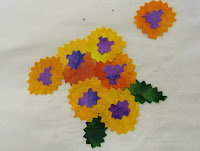I have completed the cot quilt and sent it off to Laurence Stanley Osmotherley (poor little blighter!) with a sigh of relief. So now I am able to concentrate on my still life study, with flower vases. My method of preparing the background and a sample vase has been demonstrated in previous blogs. I have made several more vases of differing shapes and now I need to arrange them on the background, on a design wall. This is when the camera comes into its own. I have placed four possible arrangements of the vases side-by-side so I can easy judge which I prefer.
1
2
3
4
My musings: I like the position of the vase on the right, as it seems to be basking in the full impact of the light source.
I also like the dark blue vase directly behind it.
In #1 I don’t like the fact that the 3 vases on the left hand side are placed in a line.
I don’t particularly like the position of the tall purple vase on the left hand side in #3 and #4. I prefer it slightly off centre, as in #2
My preference seems to be leaning towards #2 as long as the large vase on the left hand side is moved forward.
Here is the adapted arrangement I have selected.
Selected arrangement
And now for the flowers: I rarely do what is called ‘fussy cutting’ because it is so wasteful on fabric, but I did cut out individual flowers and leaves from this small piece of stamped batik fabric to make an arrangement for one of the vases.
Fussy cutting
I use pinking shears to cut them out and work with an iron on a sheet of baking parchment. I place the intended vase on the parchment and arrange the flowers to see what they looked like. They over-lap slightly, so once I am satisfied, I use the iron to stick them all together. Once they have cooled down, it is easy to peel them off the parchment and pin them back in place on the design wall. Nothing is stuck in place at this stage so there is still flexibility as the picture develops.
Flower arrangement
Placement
There are many ways to make simple flowers; here are a couple more ideas. I make a daisy with a semi-circular centre and curved petals. A primula can be a circle with a small contrasting shape inside. It’s good to play with ideas and I am now in a position to steam ahead with this project over the coming week.
Daisy
Primula
I can make these independently, and then audition them in situ on my design wall.












No comments:
Post a Comment